
The Nokia 6170 was one of the clamshell phone series from Nokia.

The Nokia 6170 was one of the clamshell phone series from Nokia.
It comes with a VGA camera (640x480) with 2x and 4x electronic zoom, push to talk and speakerphone. [1]
It has a built-in WAP web browser, and supports Java ME. It has 2.3 MBs integrated memory that can't be extended (and some elements that ship inside the phone's file system are impossible to delete).
The phone supports IRDA but not Bluetooth, and can send and receive multimedia messages of up to 100 KBs in size.
The phone has a metallic look and spots a small colour screen on the outside of the clamshell.
The European version 6170 RM-47 supports 900 MHz, 1800 MHz and 1900 MHz radios, while the U.S. version 6170b RM-48 supports 850 MHz, 1800 MHz and 1900 MHz radios.
It was the successor of Nokia 6102i and succeeded by the Nokia N71 which was released in June 2006.
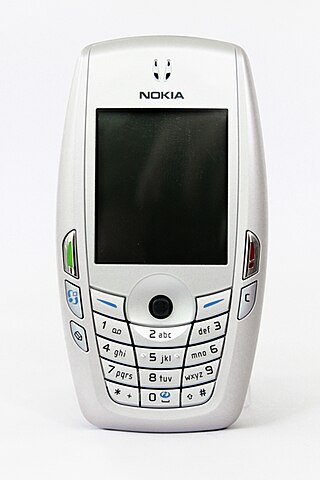
The 6620 is a smartphone created by Nokia, announced in 2004, running on Series 60 2nd Edition and the Symbian operating system. It was the first EDGE-capable phone for the Americas' market.

The Nokia 6230 is a mobile phone based on the Nokia Series 40 platform. It was announced on 28 October 2003 and released in February 2004.
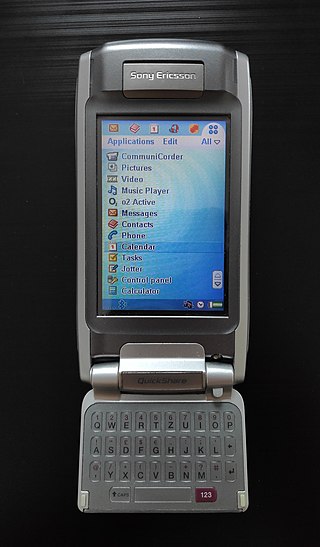
The Sony Ericsson P910 is a smartphone by Sony Ericsson introduced in 2004 and the successor of the Sony Ericsson P900. The P910 has a full QWERTY keyboard on the back of the flip. The biggest change from the P900 to the P910 is that the P910 supports Memory Stick PRO Duo and the phone's internal memory has been upped from 16 MB to 64 MB. Although Memory Stick PRO Duo comes in larger capacities, the maximum supported by the P910i is 2 GB. It is powered by an ARM9 processor clocked at 156 MHz and runs the Symbian OS with the UIQ graphical user interface. Also, the touchscreen displays 262,144 colours, as opposed to the P900's 65,536 (16-bit). It comes in three versions:
GSM frequency bands or frequency ranges are the cellular frequencies designated by the ITU for the operation of GSM mobile phones and other mobile devices.

The Nokia 9300 is a Nokia Series 80 Symbian Smartphone introduced in 2004. It is used as a normal though bulky mobile phone in closed mode, when it is flipped open it can be used like a very small notebook computer with a 640×200 screen. The phone also has speakerphone functionality, which is activated automatically when the phone is flipped open. An MP3 player is also built into the phone. It didn't have vibration motor due to its shape.
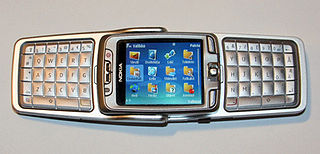
The Nokia E70 is a candybar/fold keyboard type smartphone from the Eseries range, announced in October 2005 and released in May 2006. There are two models of this phone, the E70-1 for the world market with tri-band GSM and UMTS, and the E70-2 for the Americas with tri-band GSM and EDGE packet data capability. Both models use the S60 platform 3rd Edition on top of Symbian OS version 9.1.
The Nokia 8850 is a mobile phone handset manufactured by Nokia. It was a light alloy-bodied enhanced version of Nokia 8210 model with slider protection of the keypad and white lighting of the keypad and screen. The 8850 is considered to be an un-repairable phone, thus resulting in very few active handsets in the market. Today it remains a collector's item. It also came in gold. It was introduced as a successor of an earlier model, the chrome phone Nokia 8810.
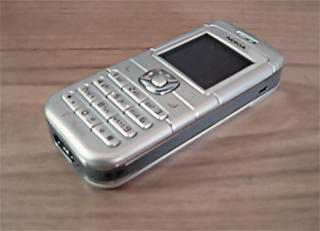
The Nokia 6030, introduced in Q1 2005, is a GSM dual band handset operating on frequencies 900 and 1800 MHz, with automatic switching between frequencies. It is small in size with dimensions of 104 x 44 x 18 mm and weighs 90 grams. It also has 3MB Shared Memory.
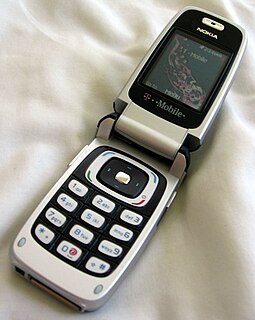
The Nokia 6103 is a mobile phone based on the Nokia Series 40 platform and the Nokia 6103 builds upon the popularity of the 6101. It features a TFT display supports up to 65,536 colors .The phone also has a secondary external mini display that supports up to 4,096 colors. More key features include Bluetooth wireless technology, FM radio and camera.

The Nokia 6101, 6102, and 6102i are a line of popular Nokia mid-level clamshell cellphones that operate on GSM-850/1800/1900 MHz frequencies released between middle 2005 and early 2006. The line was given the nickname Ediphix by Nokia employees.
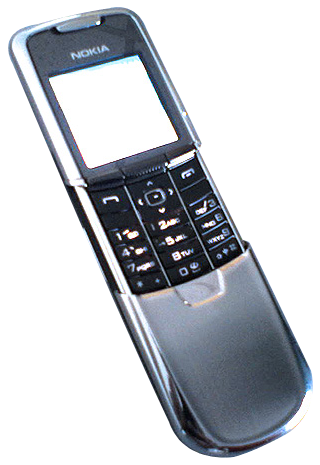
The Nokia 8800 is a luxury mobile phone produced by Nokia, based on the Nokia Series 40 operating system. The 8800 features a stainless-steel housing with a scratch-resistant screen and has a weight of 134 grams. According to Nokia, the 8800's "sophisticated slide mechanism uses premium ball bearings crafted by the makers of bearings used in high performance cars".

The Nokia N93i is a smartphone produced by Nokia, announced on 8 January 2007 and released the same month. It is part of the Nseries line and is a redesign of the Nokia N93. The N93i runs on Symbian OS version 9.1, with the S60 3rd Edition user interface. Like the N93, it is a clamshell and swivel design with a camera and landscape position.
The Nokia 6000 series or Classic Business series is range of mobile phones marketed by Nokia. This family of phones is notable for their conservative, unisex designs, making the family popular with business users.

The Nokia 6070 is a mobile phone made by Nokia. It operates on GSM tri band frequency 900, 1800 and 1900 MHz, with automatic switching between frequencies. It is small in size with dimensions of 105.4 x 44.3 x 18.6 mm and weights 88 grams. It was released in the second quarter of 2006. The phone runs using Nokia S40 second edition. The features include a VGA camera, FM radio and voice recording.
The Nokia 6800 series are a selection of Nokia Series 40 phones with an unusual fold-out QWERTY keyboard. This type of keyboard is also used in the more recent Nokia Series 60 Symbian-based Nokia E70. These phones were marketed as "messaging devices": all had built-in email clients, and some had BlackBerry support.

Nokia 5300 XpressMusic is a slider mobile phone by Nokia, part of the XpressMusic range. It was introduced on 26 September 2006 and released at the end of that year. It runs on Nokia Series 40 3rd Edition FP2.

The Nokia 6280 Series, is a series of slider type phones first released in Q4, 2005.
The Nokia 6650 fold is a Nokia smartphone announced in March 2008, running Symbian OS. It is a Hex-band unit using GSM 850, 900, 1,800, and 1,900 MHz networks and UMTS 850 and 2,100 Mhz networks. Also noted as a quad-band clamshell 3G smartphone, it was released in June 2008. It was sold through AT&T Mobility in the U.S. It is AT&T's replacement for the S60-powered N75. It was manufactured in three colors, metallic silver, black, and red. It was never a global model, and therefore it was sold exclusively for T-mobile networks in Europe. Models were RM-324 for North America and RM-400 for Europe.
The Nokia 6301, approved by the FCC for the US market in January 2008, is a triband GSM mobile phone. The North American model 6301b is equipped with 850/1800/1900 MHz bands. The European model 6301 is equipped with 900/1800/1900 MHz bands.
The Nokia 6210 Navigator is a smartphone made by Nokia that is a successor to Nokia 6110 Navigator. It was announced on February 11, 2008 and had been available from July 2008. It runs on Symbian OS v9.3 with a S60 3rd Edition FP2 user interface.